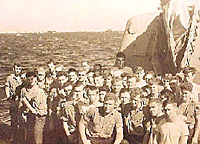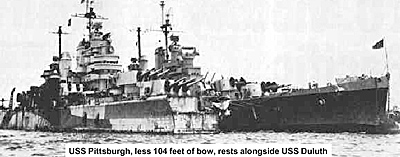The First Typhoon December 18, 1944
On December 16th, 1944 Halsey’s Third Fleet, Task Forces 38, had just completed a three-day attack on Luzon in support of the invasion of Mindoro in the Philippines.
Halsey’s mission was to support General MacArthur’s invasion of the Philippines by attacking Japanese airfields and suppressing Japanese air operations from December 14th to the 16th. After three days of continuous action his ships were very low on fuel. Some destroyers dangerously low.
By December 17 the Third Fleet had retired out of Japanese aircraft range to refuel as scheduled. The timing of this operation was critical. The Third Fleet had to refuel to be able to return by December 19 to support ground operations.
On the 17th Halsey attempted to refuel his fleet in spite of worsening weather. Finally, weather caused Halsey to totally suspend fueling operations the afternoon of the 17th and he rescheduled fueling to resume at 0800 hours on the 18th 200 miles northeast of their present position based on advice from Commander George F. Kosco, his fleet weather officer.
Halsey would change the refueling rendezvous twice more that day hoping to find calmer waters. The final course change unfortunately resulted in part of his fleet sailing directly into the path of the typhoon. On the afternoon of the 18th of December Halsey finally admitted a typhoon was present but contemporary captains and officers in his fleet testified that all the classical criteria barometric and weather indications had been met much earlier. By the time it was declared they were already in it and the fleet was scattered over 2,500 square miles of ocean.
 Survivors from the Spence and Monaghan
Survivors from the Spence and Monaghan
Thus the argument used, by those blaming Halsey for losses caused by the storm is as follows:
Halsey, by not allowing himself to recognize the weather was such that it would prohibit refueling on the 17th and denying the presence of a major storm center or the possibility of a typhoon lead to critical delays that prevented his fleet from avoiding the typhoon’s path. It is also argued that Admiral Halsey did not pay sufficient attention to his destroyer’s fuel levels.
Halsey’s defense was that there was no warning of the storm by the Pacific Fleet Aerological Service. Material damage to his fleet, while extensive, was totally overshadowed by the loss of almost three entire destroyer crews and their ships.
Admiral Nimitz flew into the fleet’s anchorage at Ulithi from Pearl Harbor on December 25 to personally find out what had happened. He ordered a Court of Inquiry to investigate the losses.
Hearing findings indicated that due to lack of timely orders the ships lost were still attempting to maintain their positions at time of capsizing. It also found that of the Farragut class destroyers, the Hull and the Monaghan had capsized and two others the Dewey and the Aylwin had come perilously close to capsizing and were basically unstable, a condition aggravated by their empty fuel bunkers. (Not until after Halsey’s second typhoon were the Farragut class of destroyers declared unfit for normal service and ordered decommissioned in October of 1945.)
The court of inquiry concluded on January 3, 1945 that Halsey’s errors were “errors in judgment under stress of war operations and not offenses”. This finding was sent to and endorsed by Nimitz, Halsey’s immediate superior. Fleet Admiral King who sent the final version to Secretary of the Navy James Forrestal which read, “… although the preponderance of responsibility for the storm damage and losses suffered attaches to Commander Third Fleet (Halsey), there is no question of negligence involved.”
“The mistakes made were errors in judgment resulting from insufficient information, committed under stress of war operations, and stemmed from the firm determination to meet military commitments.”
On January 25, 1945 Halsey turned over command of the Third Fleet as planned to Spruance. A cruiser captain at the time observed “My feeling was one of confidence when Spruance was there and one of concern when Halsey was there.”
The Second Typhoon -- June 5, 1945
On May 28 it was Halsey’s returned to command the Third Fleet. By June 2d his aircraft were attacking Kyushu. He then received his first warning of tropical disturbances to the south and west from the CINCPAC weather service. Halsey ordered a typhoon alert on the 3rd. Commander George F. Kosco, Third Fleet aerologist, felt the weather warning from CINCPAC was wrong. Kosco believed that the storm was further southwest of the plotted position.
There were actually two separate storms developing on June 4th. When another message from CINCPAC warned of one storm 160 miles southwest of Halsey’s Task Force and a second 375 miles south southwest Kosco again “disregarded” the warning. He felt there was only one storm, that the storm center did not agree with the historical record, and though the message said the storm was moving north, Kosco did not believe it could move north. Six hours later the warning was repeated with more details and again Kosco and Halsey “discounted the report as it indicated two storms”.
From late June 4th until June 5th Halsey would continually disregard accurate radar plots of the storm center trusting rather in his staff’s and his own assessment of the storm’s location. At one point he ordered his fleet, in spite of these radar plots, on a course directly crossing the typhoon’s path. The most damning action by Halsey was his personally refusing a request by Admiral Joseph J. Clark, Commander of Halsey’s Task Group 38.1 for permission to leave formation on a course, which would have enabled Clark’s ships to avoid the brunt of the storm. This after Clark reported his own radar was accurately tracking the storm center. Six sailors and officers were lost in the storm. Major damage was inflicted by this typhoon on the aircraft carriers Bennington, Hornet, Windham Bay and, Salamaua.
 Three cruisers including the Pittsburgh, whose bow was ripped off, suffered major damage. In total 146
aircraft were damaged beyond repair.
Three cruisers including the Pittsburgh, whose bow was ripped off, suffered major damage. In total 146
aircraft were damaged beyond repair.
USS Pittsburgh (front) sans bow.
Another court of inquiry was held as a result of the losses. It was less friendly than before and found, that with the information available Commander Third Fleet Admiral W. F. Halsey and Commander Task Force 38 Vice Admiral J. S. McCain should have been able to avoid the typhoon. The findings stated, “that serious consideration should be given to assigning” both of them to other duties.”
James V. Forrestal, Secretary of the Navy, wanted to immediately retire Halsey but Nimitz in his review of the court’s finding and referencing Halsey’s extensive combat record disagreed. King went along with Nimitz’s recommendation. The war with Japan would end in two months it just wasn’t worth disgracing a popular American hero. In formal reply to both the above typhoon incidents Halsey laid total blame on lack of accurate weather information. Not until February of 1981 did the navy release the entire correspondence on the reviews of the courts of inquiry. There were no smoking guns, no hidden agendas.
It has been suggested that Halsey’s promotion to Fleet Admiral, was delayed until December of 1945 due to the two typhoon losses. To paraphrase J.J. Clark who said of Halsey: “...by 1944, the war had become too complicated for Halsey. But before that, Halsey was the only one man to turn the problematic situation at Guadalcanal in favor of the Allies.”
After 1943 the war in the Pacific simply became too complex, the fleets too immense for a shoot from the hip gunfighter like Halsey.
Another Point Of View
The key points for judging Admiral Halsey guilty of dereliction of duty, gross poor judgment or having acted in a manner, which should have resulted in his relief from command, are in my opinion simple to address. First one simply must ask how bad was the loss. What follows is a comparison of Halsey’s losses during the typhoons to other events in the war, over which commanders had far greater control.
Recall, after the first typhoon of December 1944 Admiral Nimitz compared the August 1942 Battle of Savo Island to the Third Fleet losses in the typhoon by saying “it was the greatest loss since that battle” This comparison is incredulous. What happened at Savo Island, a battle that Halsey had no connection with, was a Japanese Naval Squadron snuck between two American destroyers guarding the inlet to the landing area of Guadalcanal. These Japanese ships then in a mere thirty minutes after blowing away four heavy cruisers and one destroyer sailed away almost unscathed. A total of 1,270 allied sailors were killed and another 700 wounded.
In another event, almost unpublicized, the US escort carrier Liscome Bay during November 1943 on the last day of the attack on Makin Island was destroyed by one Japanese torpedo that hit the ship’s magazine. Lost were 650 killed. This carrier was in action supporting the invasion of Makin Island. The losses on the ship were ten times the number of men lost in capturing the island.
There was much grumbling at the time but no investigation charging that the US Army had allowed the battle to drag out too long, providing the Japanese time to attack the support ships.
Tarawa!
Betio Island the largest island in the atoll. If there was ever an action in the Pacific in WWII, where a planning commander should have been court martialed this was it. Over one thousand United States Marines and Navy personnel were killed in action and two thousand wounded in three days. To this day no one has denied that faulty intelligence on the tides and reef, inappropriate landing vessels, incredibly poor coordination between the pre landing bombardment ships and their counterpart naval strike aircraft attacks. All this accentuated by an insufficient ammunition allotment for the shelling of the beaches did not result in any commander’s relief.
In fact comparing the size in number of men, ships and, aircraft Halsey’s losses were relatively minor. Court-martialing was not necessary and in reality served no real purpose.
I’ll acknowledge up front that this article is not the result of original research or new insights. It is an out-growth of my interest in nautical miniatures. I am an avid ship model collector.
More Halsey's Typhoons
Back to Cry Havoc #39 Table of Contents
Back to Cry Havoc List of Issues
Back to MagWeb Master Magazine List
© Copyright 2002 by David W. Tschanz.
This article appears in MagWeb (Magazine Web) on the Internet World Wide Web. Other military history articles and gaming articles are available at http://www.magweb.com